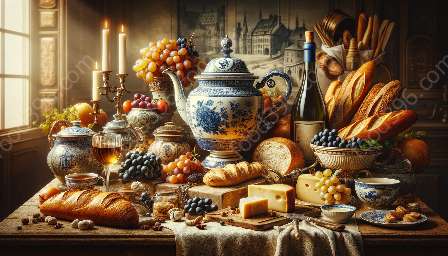The interwar period in France marked a significant era in the evolution of French cuisine, as the country emerged from the devastation of World War I and experienced a surge in culinary creativity and innovation. This period, spanning from the end of World War I in 1918 to the outbreak of World War II in 1939, witnessed the revival of traditional French cooking techniques, the emergence of new culinary styles, and the birth of iconic dishes that continue to influence modern gastronomy. To understand the cultural and historical significance of French cuisine in the interwar period, it is essential to delve into the broader context of French culinary history and its impact on global gastronomy.
French Cuisine History: A Glimpse into Culinary Traditions
French cuisine has long been revered as one of the world's most influential and refined culinary traditions, characterized by its emphasis on fresh, high-quality ingredients, meticulous preparation methods, and unparalleled attention to detail. The roots of French gastronomy can be traced back to the Middle Ages, when the nobility and clergy shaped the culinary landscape through their patronage of lavish feasts, extravagant banquets, and the cultivation of a sophisticated dining culture.
During the Renaissance, the refinement of French cuisine continued to evolve, as the royal courts and aristocracy embraced novel ingredients, exotic spices from distant lands, and the art of culinary presentation. The reign of Louis XIV in the 17th century witnessed the establishment of the first professional kitchen brigade, introducing the concept of organized culinary operations and the hierarchical structure that laid the groundwork for modern French culinary practices.
By the 18th century, France had solidified its reputation as a culinary powerhouse, with the publication of influential cookbooks, the establishment of notable culinary academies, and the codification of classic French dishes. The French Revolution further transformed the culinary landscape, as the demise of the aristocracy led to the democratization of dining, thereby expanding the reach of French culinary traditions across social classes.
French Cuisine in the Interwar Period: A Culinary Renaissance
The interwar period heralded a resurgence of French gastronomy, as the nation sought to reclaim its culinary heritage in the aftermath of the devastation wrought by World War I. Despite the economic hardships and social upheaval that characterized the post-war era, French chefs and restaurateurs demonstrated resilience and adaptability, fueling a culinary renaissance that left an indelible mark on the world of food.
One of the defining characteristics of French cuisine in the interwar period was the renewed emphasis on regional culinary traditions. Chefs and food enthusiasts turned their attention to the unique culinary identities of France's diverse regions, championing local ingredients, traditional recipes, and time-honored cooking techniques. This celebration of terroir not only elevated the appreciation of regional specialties but also contributed to the preservation of authentic flavors and culinary heritage.
Moreover, the interwar period witnessed the rise of influential culinary figures whose innovative approaches revolutionized French cooking. Visionary chefs such as Auguste Escoffier, Fernand Point, and Alexandre Dumaine played pivotal roles in redefining haute cuisine, introducing modern kitchen management practices, and elevating the status of fine dining establishments. Their creative ingenuity and commitment to culinary excellence set the stage for the golden age of French gastronomy that would follow.
Notable Culinary Innovations and Iconic Dishes
The interwar period gave birth to several iconic French dishes and culinary innovations that continue to tantalize palates around the world. From the iconic Salade Niçoise, a refreshing medley of fresh vegetables, olives, and tuna, to the decadent Coq au Vin, a rustic stew of chicken braised in red wine, the era yielded a treasure trove of timeless recipes that have secured their place in culinary history.
Additionally, the period saw the advent of nouvelle cuisine, a revolutionary culinary movement that favored lighter, more contemporary dishes and emphasized the importance of fresh, seasonal ingredients. This departure from the rich, heavily sauced dishes of traditional haute cuisine sparked a culinary revolution, influencing chefs globally and paving the way for modern culinary trends focused on simplicity and natural flavors.
Legacy and Influence
The legacy of French cuisine in the interwar period endures as a testament to the resilience, creativity, and enduring appeal of French gastronomy. The era's culinary innovations, commitment to culinary excellence, and celebration of regional diversity continue to permeate modern cooking practices, inspiring chefs and food enthusiasts to pay homage to the timeless traditions of French culinary heritage while embracing innovation and creativity.
French cuisine in the interwar period not only left an indelible mark on the gastronomic world but also reflected the resilience and spirit of the French people in the face of adversity. Today, the rich tapestry of flavors, techniques, and traditions that emerged during this transformative era continues to captivate culinary aficionados and serves as a poignant reminder of the enduring legacy of French cuisine.

